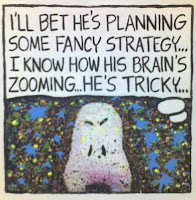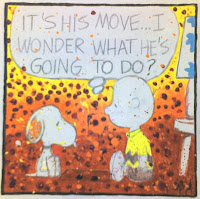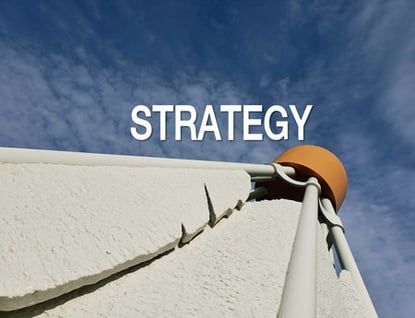 Over the weekend, I finished the first large painting I’ve done in more than a decade. This was prompted by the prospect of losing a cool Howard Finster print that’s been in my office for years at work. I learned of the possibility on a Friday and by Saturday night, I’d purchased a canvas, new paints and brushes, and was gridding out a Peanuts cartoon to do a painting in Tom Everhart’s style.
Over the weekend, I finished the first large painting I’ve done in more than a decade. This was prompted by the prospect of losing a cool Howard Finster print that’s been in my office for years at work. I learned of the possibility on a Friday and by Saturday night, I’d purchased a canvas, new paints and brushes, and was gridding out a Peanuts cartoon to do a painting in Tom Everhart’s style.
While painting, I thought about the very productive bursts of artistic creativity followed by long droughts that have marked my life. I’ve always attributed the periods to major life changes (going to grad school, getting married, buying a house), but it doesn’t explain other creative periods, i.e. a tremendous output early in high school and doing a lot of cartooning the past few years – much of it on paper table cloths in Italian restaurants!
It struck me finally that the creative bursts were explained by bare walls - what triggered the output was the need to fill empty space. In each case, I’d moved into a new space with walls needing to be decorated. Some walls have been physical; others have been non-traditional – refrigerators, presentations, blogs. In each case, once the “walls” have been filled, my artistic spark has vanished.
Interestingly, the spark doesn’t come back when a previously bare wall becomes empty again. There’s a big bare area over our mantel where one of my paintings used to hang, yet there’s no inspiration to fill this empty space yet again.
My lesson from all this is that there are different types of creativity patterns. I appear to be a “utilitarian creative.” I don’t ooze artistic creativity all the time as many do. Instead, my creative juices get going only when there’s a clear need and application for the output. So in the future, when I hit a creative block, I’ll just have to find new bare walls to fill.




